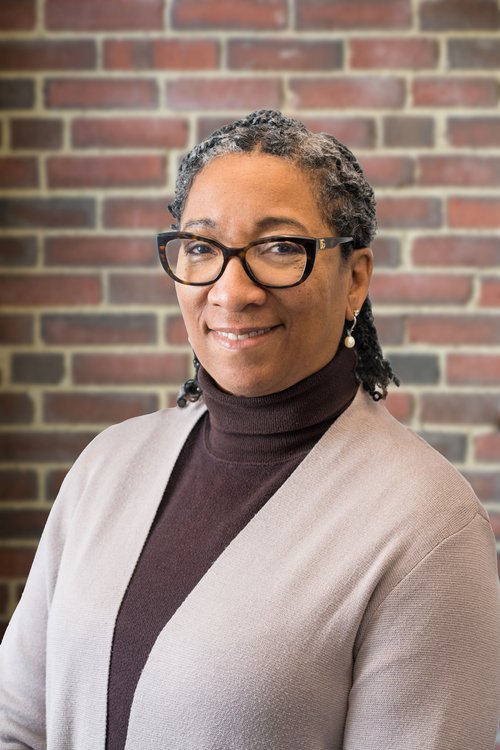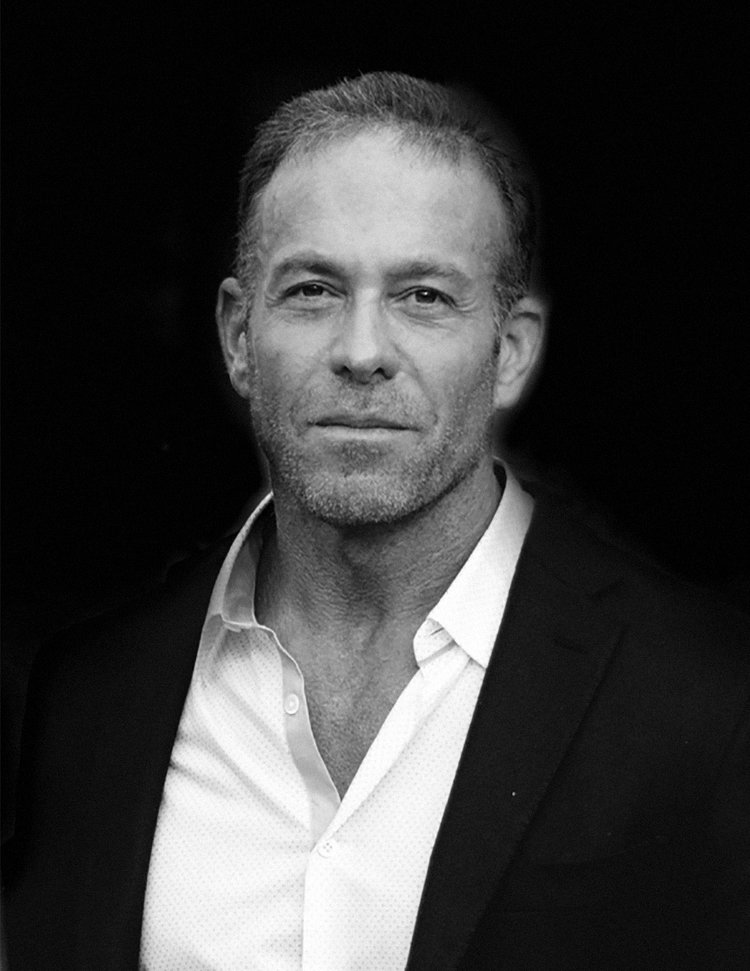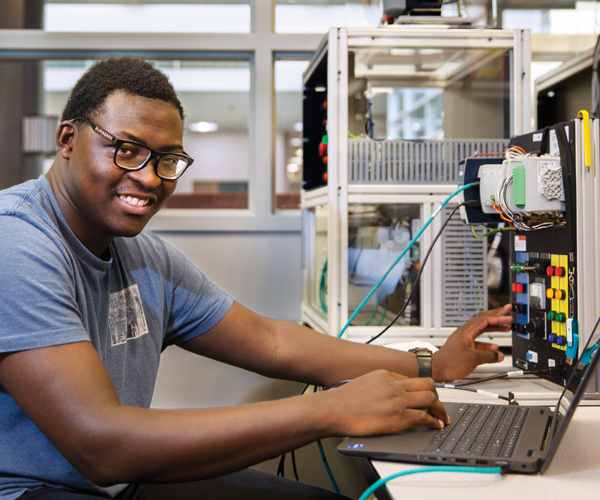Can Wind Power Bring Jobs to Cleveland?
by Robert L. Smith | Aug. 1, 2017 | 12:00 PM

Lorry Wagner’s boat drifted in the calm, blue-green water 9 miles off the coast of Cleveland. The downtown skyline was just visible in the late afternoon sunshine, a miniature city at the edge of a vast lake. Off his bow bobbed a slender yellow buoy bristling with sensors — a harbinger of big things to come.
That weather buoy has recorded winds whipping across this stretch of Lake Erie at speeds averaging 15 mph. “Better than the mid-Atlantic,” Wagner says, strong enough to spin a giant turbine — which would rise right here.
A pilot wind farm — the first on the Great Lakes — would capture the breeze to generate electricity for Cleveland homes and businesses. But that’s just for starters. Supporters see a project that would open the door to a new manufacturing industry, transform the lakefront and carry Cleveland into a clean energy age.
A bold quest demands an uncommon leader. There’s little that’s typical about Wagner, who is leading the mission as president of LEEDCo, Lake Erie Energy Development Corp.
The boat that Wagner uses to motor out to the project’s monitoring stations is a sleek, 42-foot racing boat. He named it Perelandra for the C.S. Lewis fantasy novel. It’s a tug compared to the racer he designed to win the world powerboat championship off Key West in 1992, but still one of the fastest crafts cruising out of downtown yacht clubs.
His credentials would seem to make him a good fit for a complex engineering job. Trained in nuclear fusion at Purdue University, Wagner led a number of engineering teams on advanced energy projects — including at the Perry Nuclear Power Plant — before pivoting to wind power and running his own green energy startup.
But he may be equally well served by his experience coaching the Cleveland State University women’s swim team. Wagner took charge of an unheralded team of swimmers and divers in the late 1980s and shaped it into a record-setting national powerhouse. Other top teams adopted his innovative training techniques.
Coaching introduced him to Susan, his wife of 34 years, whom he lost four years ago to cancer. Their twin boys, Tristan and Killian, are 24 and pursuing careers. At 66, Wagner is focused like a laser on his capstone project — America’s first freshwater wind farm, called Icebreaker Wind. He sees a chance to transform the city and the lakefront he loves.
“If you think about the Space Needle in Seattle, the Arch in St. Louis, there’s an iconic value,” he says, allowing himself to wax poetic about a project brimming with environmental studies and engineering. “I get emails constantly from people around the country who say, ‘When Cleveland builds this, we will come back. We want to be part of that era.’”
Wind fits Cleveland like a sock, Wagner argues, and not just because of the steady lake breeze. He points out that Clevelander Charles Brush invented the wind turbine, circa 1887, when he erected a windmill in his backyard to power the electric marvels in his Euclid Avenue mansion. “We are very good at taking industrial solutions and commercializing them,” Wagner insists. “We can take an idea and essentially mass-produce it. We can do this.”
Cleveland’s champion of wind power is a trim, athletic-looking man with a quiet energy and an easy smile. He tends to describe issues and mechanisms in detail, talking with his hands as he grows excited. But he’s more of a planner presenting data than a preacher with the answers.
He takes a long view, and he rolls with the punches.
Many had hoped the wind farm — called Icebreaker because of the ice it is designed to break — would have turbines spinning by now. Rhode Island beat Ohio into the history books when the Block Island Wind Farm started generating power last December, becoming America’s first offshore wind farm.
Wagner shrugs. “We’ll still be the second in the country and the first on the Great Lakes,” he says.
After 13 years of studies, deal making, setbacks and successes, Icebreaker has reached a new status. Observers no longer ask if turbines will rise, but when.
“We’re planning on it happening,” says Mike Foley, the director of sustainability for Cuyahoga County. “My sense is it’s going to go.”
The permit process is on track, buyers have been found for 65 percent of the power, and a key business partner is on board. Norway-based Fred.Olsen Renewables, one of the largest wind energy producers in Europe, will build, maintain and eventually own the farm.
Construction is scheduled to commence in the summer of 2019.
The project calls for six, nearly 500-foot-tall turbines marching in a line toward Canada 8 to 10 miles northwest of downtown Cleveland. An underwater cable will connect them to a Cleveland Public Power substation and the regional high-voltage power grid. The farm will generate a modest amount of electricity by power plant standards. The point is to demonstrate that wind power works on the Great Lakes, and that Cleveland can build windmills.
“This is really important for us,” says Foley, who is charged with growing green jobs in Cuyahoga County. “If the pilot project works, there will be more than six turbines out there. There will be hundreds of turbines out there.”
The Cleveland Advantage
Europe is far ahead of the U.S. in wind power technology, and European specialists are a big part of Icebreaker. The turbines will be patterned after those off the icy coast of Finland. Danish engineers designed the giant suction cup-like “mono buckets” that will anchor the turbines to the lake floor.
But some of the design work is coming off local drawing boards, and Cleveland firms are expected to supply many of the pieces and parts — from the turbine foundations to the aerodynamic blades to coatings and lubricants. The idea is to tap the region’s manufacturing prowess to position Cleveland as a hub in a wind power supply chain.
That’s why companies like Cleveland-based AT&F — formerly American Tank and Fabricating — are watching with anticipation.
“We have the capacity to fabricate the very large steel components,” says CEO Michael Ripich. “Capacity that was created for other industries, like defense and construction and mining equipment, is ready to serve wind energy. It’s already here. It’s under-utilized.”
Cleveland is not guaranteed a lead role even on the Great Lakes, he cautions. Manufacturers in other parts of the country, particularly the Gulf Coast, are eager to supply the market. Or, wind energy companies could simply import their parts from nations that already make them.
But turbine pieces are big and clumsy to ship. The Port of Cleveland, and companies like Great Lakes Towing, could move the parts and pieces from factory to wind farm across the water, Ripich says, lending Cleveland a logistical advantage.
“Cleveland could be to offshore wind what Detroit was to automobiles,” Ripich says. “We could offer the integrated supply chain that Henry Ford envisioned.”
A Cleveland Foundation Idea
Fourteen years ago, Ronn Richard arrived in a beleaguered city to lead the Cleveland Foundation. The Plain Dealer had been running a series of stories on the “Quiet Crisis” of population and job losses. Seemingly half of Euclid Avenue was boarded up.
Richard gazed out on a big blue lake sprinkled with white sails. He told his board it was time for change.
“I said, ‘Let’s focus on new industries,’” he recalls. In addition to medicine, “Cleveland needs to be first in advanced energy. That’s the economic driver of the future.”
He still thinks he’s right.
“Coal isn’t coming back,” Richard says. “Fracking gas is much cheaper. The world is changing.”
Natural gas will be the bridge to green energy, Richard believes. When the gas play ends, the wind will still be blowing across the Great Lakes.
Icebreaker began with a wind task force formed by the Cleveland Foundation and Cuyahoga County. Wagner, whose gaze had shifted from nuclear to green energy, got involved in the project to raise the demonstration wind turbine outside the Great Lakes Science Center.
In 2009, LEEDCo was formed to pull together public and private partners and to build a wind farm. The quest identified, a knight was needed to lead it. Richard, LEEDCo’s founding chairman, turned to Wagner. He says he liked his technical expertise but also his spirit.
“LEEDCo is a startup,” Richard says. “We needed an entrepreneur but also someone with a passion for the environment and a passion for the industry.”
Wagner was busy running Azure Energy, a renewable energy developer, with his wife.
“I really wasn’t that interested,” he says. “My wife said to me, ‘You’re going to take the job.’ She said, ‘This is right up your alley.’
“It was the right decision, and I’m lucky she saw that,” he says.
Wagner has always been drawn to the water, especially in a competitive environment. He swam for Cleveland Heights High School and coached the neighborhood team at the Forest Hills swim club. He met his wife on a pool deck in West Lafayette, Indiana, near the Purdue campus. Both were coaching high school swim teams.
Wagner left competitive powerboat racing in 1992, after the twins were born, but he stayed close to the water. A scuba diver, he’s one of the original members of CLUE, Cleveland Underwater Explorers, a dive group that hunts for Lake Erie shipwrecks.
One of its members, David VanZandt, a friend since Purdue, is a rocket scientist and an underwater archeologist. VanZandt is, in fact, one of only four underwater archeologists in Ohio. He says Wagner is an equally rare breed.
“We’re probably the best divers in the lake right now,” he says matter-of-factly.
VanZandt supports Icebreaker, believing the masts will draw aquatic life back to dead zones in the lake, much like a pier does in the ocean. He says his diving buddy is a good choice to lead a pioneering energy project.
“He’s more of an interdisciplinary engineer. He has multiple talents,” VanZandt says. “We’re all curious. We’re scientists and engineers. We want to know what makes things tick.”
But Wagner has a quality that sets him apart from the white board crowd.
“He’s pretty much a people person,” VanZandt says.
Connections are as important as science in a $125 million engineering project. At a wind conference in the Canary Islands in 2013, Wagner met Fred Olsen IV, the Norwegian billionaire who founded Fred.Olsen Renewables. They shared an interest in shipwrecks and boat racing.
When the conversation turned to Lake Erie’s wind potential, Wagner was astonished.
“He knew as much about Lake Erie as I did,” he says.
It was Olsen who alerted Wagner to the mono buckets that could anchor the turbines without expensive and environmentally disruptive pile driving. Later, his company signed on as the project’s top business partner. That relationship helped attract a $40 million grant from the U.S. Department of Energy last May, propelling an improbable quest toward a finish.
“This project has overcome so many obstacles. It’s just a miracle that it’s still going,” says civic leader Dick Pogue, who has served as advisory director for LEEDCo almost since the beginning. “And a lot of that is attributable to Lorry Wagner and his colleague Dave Karpinski [LEEDCo’s vice president of operations]. They just kept their heads down and kept going.”
Wagner sees a new industry dawning rather quickly. He says Icebreaker is drawing interest from Canadian provinces and from other Great Lakes states.
“They’re all saying, ‘Let’s see them do it,’” he says. “And that will change the landscape for the Midwest. Because if we show it can work, more and more of these states will say, ‘Wow, let’s do that, too!’”
On a recent afternoon, Wagner hopped aboard the Perelandra and motored out to the Five Mile Crib, the orange, barrel-like, water intake station that stands 5 miles from the Kirtland Pump Station and about 3.5 miles from shore.
A 160-foot meteorological mast jutting from its peak makes the crib one of four monitoring stations feeding data to a project with ceaseless questions. How strong is the wind? Do birds fly by? How about bats? Will fish be affected?
He cruises another 5 miles to the yellow weather buoy. From here, the shoreline is dominated by the downtown skyline and something more — the infrastructure of an aging energy industry. Smokestacks tower over the huge coal-burning plants at Avon Point and Eastlake. Farther east, a white plume hangs above the cooling tower at Perry.
Less obvious is a turbine turning aside the Lincoln Electric plant near the East Shoreway. The Icebreaker turbines will be only slightly larger, so the Lincoln Electric turbine offers a clue to the coming view. Appearing smaller than a dime on the horizon, it resembles a small pinwheel twirling in the breeze.
“I wish everyone could see this,” Wagner says.
For 100 years, he says, the lakefront has been strung with the riggings of heavy industry. In the age of windmills, he believes, it will become a setting for green energy and recreation.
He guns the engine and steers the Perelandra into the wind, cutting a narrow wake across a big and empty lake.
Trending
-
1
-
2
-
3
-
4
-
5










